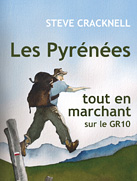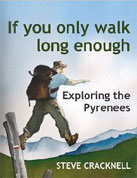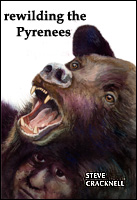We only go into the butchers in Leítza to buy some muslos de pollo – literally chicken muscles but we leave with directions for a museum dedicated to a different kind of muscles – human ones.
The walls of the shop were plastered with photos of massive stones being lifted by hulky men. These must be harrijasotzaile.
“Who are they?” I ask in my simplified Spanish, pointing to the men in the photos.
“My father and my brother,” explains the butcher.
The stones on their shoulders are labelled 250kg, 294kg; most are rectangular blocks but some are spherical. There is a trophy on one shelf. Looking at the butcher, I guess that he doesn’t participate but I ask anyway.
“Do you do it?”
“No.”
“Why?”
“I prefer fiestas.”
 By way of explanation he sends us off to a museum just out of town. When we arrive at Peru-Harri, we tell the guide where we have come from.
By way of explanation he sends us off to a museum just out of town. When we arrive at Peru-Harri, we tell the guide where we have come from.
“The butcher’s my son,” she says, followed by something which we subsequently interpret as: “My daughter, Maite, will get you an orange juice.”
The daughter notices our blank looks, and admits: “My mother does talk rather quickly.”
The tour begins and the mother, also called Maite, points out the hillside opposite the museum: the dolmens (one capped by a Basque beret), the standing stones, the stone circles, the stone slab walls, and the silver-painted stone statues, all new – all larger than life.

To the right of the sculpture the slab lists 12 Basque words: eskertu (to thank), eskaini (to give), eskatu (to ask for), eskuratu (to take charge of) … all connected with the word for hand – esku.
For her family, she explains, stone is symbolic. A link with the past. A part of Basque identity. And harrijasotze – lifting stones – embodies all that is best in Basque culture: physical and mental strength, and hard work. She talks with undisguised passion. Unfortunately we can understand little, and none of the jokes which keep the coach party laughing. I become progressively more fascinated by the woman herself. She is noticeably female, slim, fragile, elegant, vivacious, extravagant and babbling. She is disconcertingly petite.
Naturally, most of the museum is dedicated to harrijasotze. In the late 1980s it was her husband Iñaki Perurena, who hauled a 320kg stone up onto his shoulder, creating a new world record, and at the same time lifting his sport out of its obscurity. (He also competes in another Basque sport – poetry competitions, in which the poets have to improvise alternate lines on a given subject.)
On 8 February 2003 her son Iñaxio Perurena spent a whole day lifting a stone from the ground onto his shoulder. The stone weighed 100kg. He lifted it 1,700 times. It took him 9 hours, 9 minutes, 39 seconds. (In 1999, his father had only managed 1,000 lifts – in 5 hours.)
Maite does manage to charge the exhibits with emotion, but what the museum lacks is the physical presence of its heroes, the grunts and groans, the dripping sweat and the sheer strength radiating from their muscles.
The museum is dedicated to stone, claims Maite. It is true, but really it is a temple dedicated to ancestor worship – except that the ancestors are still living. The stones are cult objects and she is one of the handmaidens. What does she think of her butcher son, I wonder.
We went to Leítza just to sample cider. Only when I research on the internet afterwards do I realise that quite by chance we stumbled on the shrine to a world champion.
More [in Spanish]











Footprints on the mountains